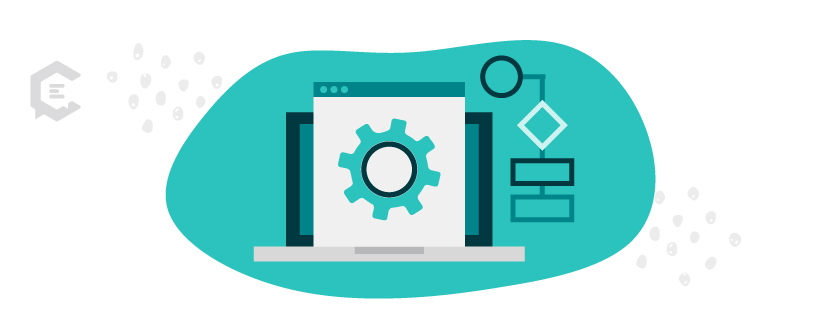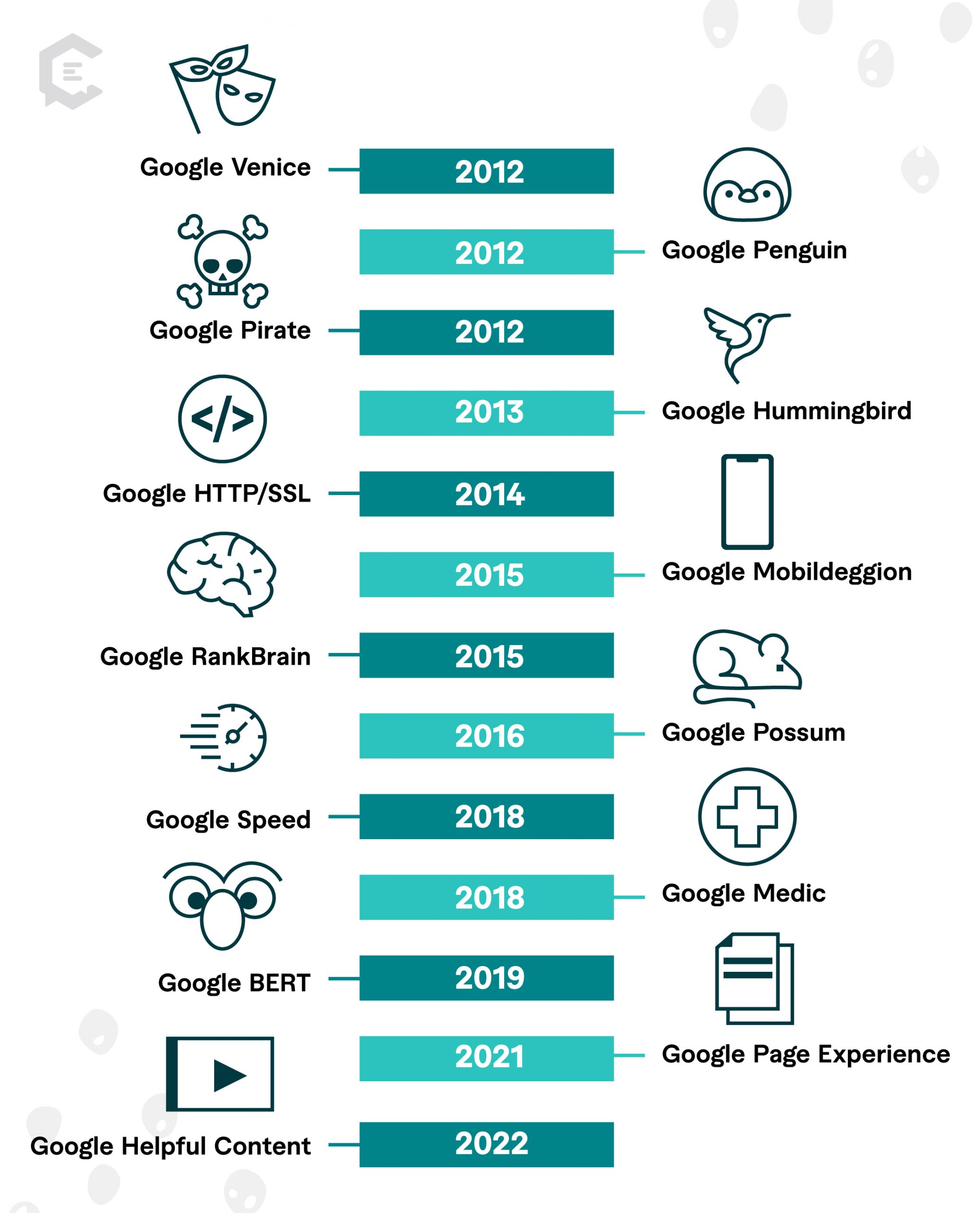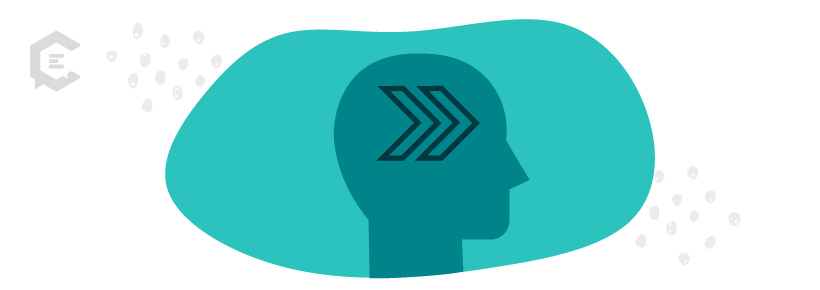When Google arrived on the scene, it changed the way people used the internet forever. Since that time, the search engine evolved to help make access to the internet easier.
As such, the Google algorithm history consists of ongoing tweaks and changes. The goal? To ensure high-quality user information, while avoiding spammy content.
This article will chronicle the history of Google algorithm updates from PageRank to modern day.
What is the Google algorithm?
The Google algorithm is a complex system used to retrieve data from around the web in order to serve results on the search engine results pages (SERPs). Google uses a combination of algorithms and ranking factors to identify pages that best answer a search query.
For SEO content marketing, the algorithm is a guiding star and a mystery. Content is always seeking to appease the algorithm. But the inner workings of it aren’t fully known or understood.
What was the original Google algorithm?
When Google launched in 1998, it used an algorithm called PageRank. Google founders Larry Page and Sergey Brin created this software.
According to Google, PageRank operated “by counting the number and quality of links to a page to determine a rough estimate of how important the website is. The underlying assumption is that more important websites are likely to receive more links from other websites.”
Through this algorithm, it was fairly easy to see how to boost web traffic: get more links.
What was the first Google algorithm update?
Google made small updates to its search requirements over the years. But in 2011, Google really shook up the SEO world and changed SERP history with its Panda update. The Panda update was “designed to reduce rankings for low-quality sites—sites which are low-value add for users, copy content from other websites or sites that are just not very useful.”
Effectively, the Panda update took aim at websites that created content just to improve search rankings. This impacted two website types::
- Affiliate sites that primarily existed to link to other pages
- Sites with very little, or thin, content
The Panda update was also notable because Google continued to implement the change. Google periodically re-ran the Panda algorithm before adding it to the core algorithm in 2016.
Every major Google algorithm update timeline
Following Panda’s introduction in 2011, Google issued the following algorithm updates:
2012 – Venice
The Venice update launched local SEO. When it was implemented, Google acknowledged that searchers wanted to find things near their locations. After Venice, Google’s search results included pages based on the user’s set location or IP address.
2012 – Penguin
The Penguin update took aim at the original PageRank algorithm by analyzing backlinks. Previously, backlink volume mattered. With Penguin, backlink quality was key. Penguin analyzed if backlinks to a site were genuine, or purchased to trick the search engines.
This created a seismic shift in SEO. What we now think of as “black hat” techniques, like buying links, no longer added SEO value. In fact, the opposite was true. If Penguin found artificial links, Google assigned a negative value to the site involved.
2012 – Pirate
The aptly named Pirate update generated negative rankings for Digital Millennium Copyright Act (DMCA) takedown requests. The DCMA was implemented to combat illegal streaming and bootlegging. Google couldn’t tell if content actually violated copyrights. This means that it’s unclear how many DMCA violations trigger a negative ranking factor. Still, multiple copyright violations hurt rankings. As such, it’s better to avoid copyrighted content.
2013 – Hummingbird
The Hummingbird update tackled the issue of voice search. Hummingbird focused on a whole search phrase, rather than specific words. For example, a previous a search for “what makes Italian food taste good” might previously pulled content optimized for “Italian food” Hummingbird changed this, allowing Google to contextualize the query and serve results around particular flavor profiles.
Hummingbird did not appear to have any negative impacts to search. But it was a reminder to write content for humans, rather than keywords for Google.
2014 – HTTPS/SSL
The HTTPS/SSL update didn’t get a fun name. But it was important. This update gave a ranking boost to sites correctly implementing HTTPS to ensure more secure websites from a user standpoint.
2015 – Mobildeggion
The 2015 Mobile update, sometimes called “mobilegeddon,” was an algorithm overhaul designed to make SERPS more mobile-friendly. This gave mobile-friendly sites a ranking advantage in Google’s search results.
2015 – RankBrain
The RankBrain algorithm utilized machine learning to analyze past searches to improve results. Google has since said that RankBrain is one of the most important updates it created.
2016 – Possum
Built on the previous Venice update, Possum also examined the local search. This algorithm update gave rise to “near me” queries. After Possum, local results became more varied, depending more on the user’s physical location and query phrasing. This particularly helped businesses located outside of city limits but still near the user’s physical location.
2018 – Speed Update
The Mobile Speed Update of 2018 added mobile site speed as a ranking factor. As visitors wanted information quickly on mobile devices, slower load speeds cost SERP rankings.
2018 – Medic Update
The Medic update emphasized and focused on a website’s expertise, authority, and trustworthiness (E-A-T). Medic impacted pages related to user well-being and happiness like:
- Medical
- News
- Science
- Finance
- Law
This update is sometimes called the “Your Money, Your Life” or YMYL update. These topics require an extra level of care and authority due to potential user impact.
2019 – BERT
According to Search Engine Land, the BERT algorithm (Bidirectional Encoder Representations from Transformers) is a deep- learning algorithm related to natural language processing. This update placed an emphasis on high-quality, well-written content.
2021 – Page Experience Update
The Page Experience update added a whole new ranking factor to the mix. After 2021, Google considered “metrics that measure real-world user experience for loading performance, interactivity, and visual stability.” Page Experience covered user experience issues like long load times, poor mobile optimization, and lagging images. The best way to monitor page-experience performance is through Google’s Core Web Vitals. This is accessible through the Google Search Console.
2022 – Helpful Content Update
The Helpful Content update increased the focus on human-centric content. In other words, it measured the effectiveness of content in increasing user experience and satisfaction, versus keyword stuffing or lazy SEO.
Staying ahead of Google updates
In most cases, content marketers find out about Google’s algorithm updates after the fact. But updates over the past several years focus on user experience and search. The best path to a positive ranking requires knowing your audience. With this information, you can develop messages that resonate. You also generate content that meets users queries and that provides solutions to questions.
The best tips to optimize content include:
- Writing for your user, not a robot
- Showing and citing your sources
- Providing value
Aside from core changes that rock the world for content marketers, Google’s algorithm shifts in small ways every single day. We can help build your brand’s SEO to drive visibility while driving engagement. Get in touch with us today to get started!






